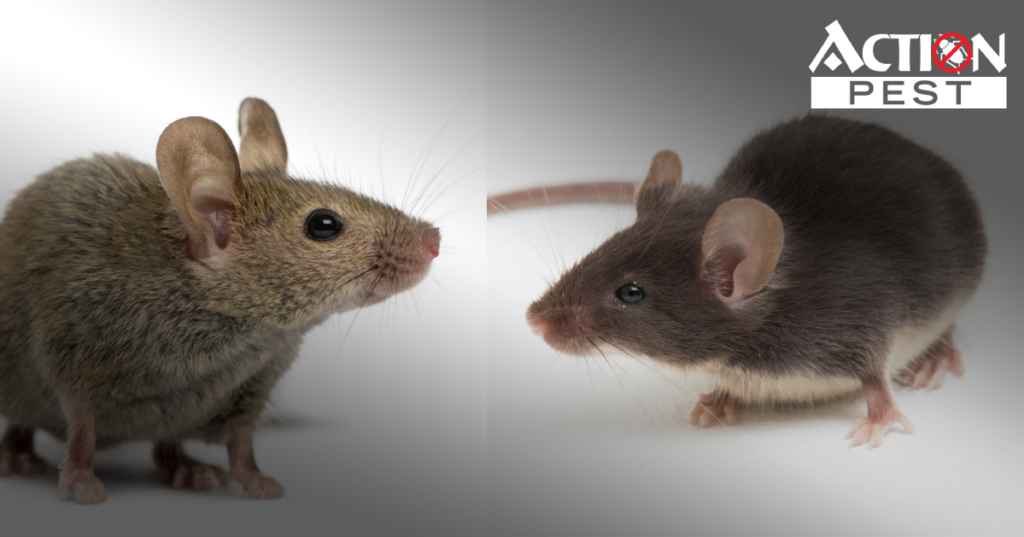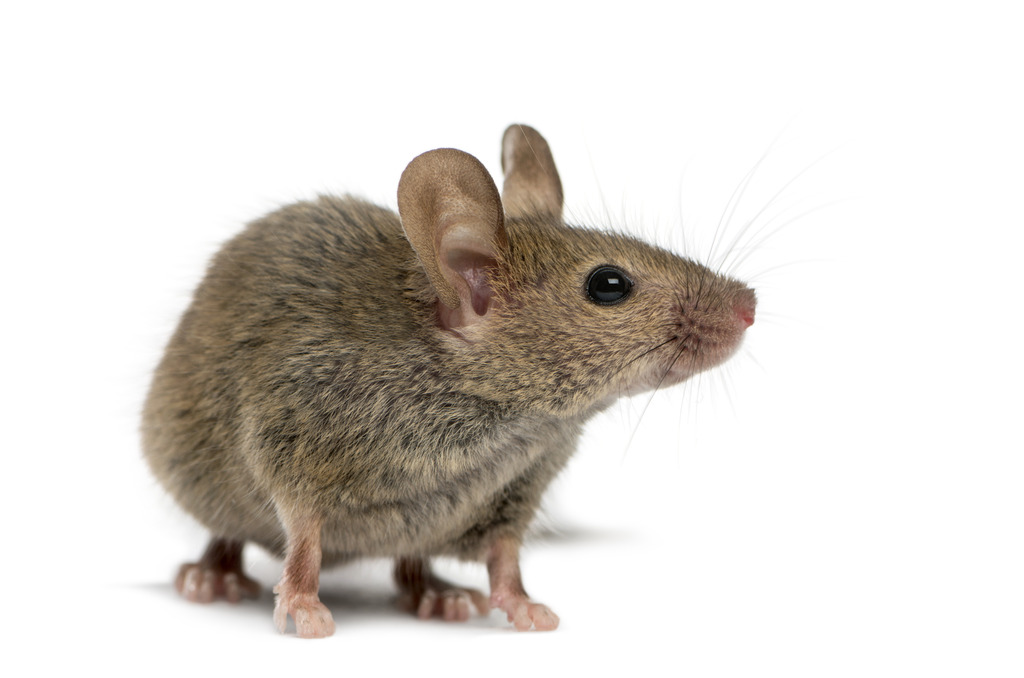
It’s night, you’re half asleep, and you decide to grab something from the kitchen. As soon as you switch on the lights, a tiny furry rodent scurries around and you’re not sure what you saw in all that panic!
Most likely it was a house mouse or a rat. It is important to make a distinction between rat vs mouse because controlling them requires different efforts and traps, and most importantly, dealing with health hazards is different when looking at mouse vs rat infestations.
Rat vs Mouse Physical Differences
Rats and mice, tend to hide from humans, but if you have more than one of these little rodents, you can spot them and identify which one has invaded your comfortable living space and try to use some of the controlling tips.
Size
The easiest way to differentiate between a mouse and a rat is by their size. Mice are much smaller than rats. They grow to about 8 inches long, with their tails making up half their size.
Rats have much larger physical features and longer bodies. They can grow to about double the size of mice, around 18 inches.
Colour
Mouse vs rat colours is another way to make a distinction. Mouse (Mus musculus) generally are brown, white, or light grey. They have coloured fur on their tails and the colour pattern runs throughout their length.
Head
House mice have triangular snouts. They have small heads but large eyes and sharp muzzles.
Rats have large heads. Their eyes do not shine like beads, as they are much smaller than mice. They have wide muzzles and blunt snouts.
Rat Ears vs Mouse Ears
Mice have large disc-like ears while rats have smaller ears that are stretched upwards.
Mouse Tail Vs Rat Tail
Looking at their tails is the best confirmation to tell them apart. Mice have fur on their tails and this is why they have coloured tails. On the other hand, rat tails are hairless, and grey and have circular patterns like circular scales wound on their tails.
Mouse vs Rat Behaviour
Mice and rats are both nocturnal animals. They spend most of their time in their burrows or nests and go out only for food and water. Rats are larger and tend to scour the outside using wider and more noticeable paths. Mice tend to use narrower paths and familiar areas to search for food. They have a good sense of smell and will follow a scent easily.
Rats tend to travel on the same line and drop or urinate as they go, to mark territory and familiarize the area. They usually travel along the walls and you will find noticeable grease marks or dark spots around the walls.
Mice can be easily caught by traps as they are small and curious in nature. They explore new routes and like to find new things. Rats stick to their diet and have little interest in searching for new food sources.
Mice are lighter than rats and good climbers. They can nest in your attic or in any tiny hole in a cabinet or behind large kitchen appliances. Their nesting material is similar to rats and includes dried grass, fabric, paper, and other soft things. Rats tend to nest on the ground and you can spot their nests in your closet, crawl space, or basements.
Signs of Rat Infestation
Spotting a rat is much harder than you think, but you can look for signs around your house to identify which rodent is invading your home.
- Droppings are the most prominent sign to look for when identifying rodents. Rat vs mouse droppings can be compared and you’ll find that mouse droppings are smaller than rat droppings. Rat droppings are between 12 – 18 mm and elongated with circular ends. Rats can produce anywhere between 30 – 50 droppings daily
- Out-of-place nesting materials are another way to identify rats. Rats chew on materials and take any soft furnishing and grass towards their nest. Locating these materials can lead you to the path a rat takes to its nest
- Rats have large teeth and need to chew on hard surfaces to keep them in size. Finding chewed-up plastic, wood or any other hard surface is another sign
- Signs of entry into food packaging and cardboard boxes
- The pungent smell of urine coming from certain areas
- Entry points towards your house from the outside and finding rat footprints around the outside can also lead you to their burrows. You can distinctly define mouse vs rat footprints by their size and pattern
Signs of Mice Infestation
Mice infestation is a bit harder to spot but the most common in North American households.
- Droppings are still the preferred identification, they have small round droppings around 1 cm or smaller. You can expect close to 100 droppings.
- Nesting material found in odd places
- Chewed-up fabric, furniture, and soft furnishings
- The pungent smell of urine, as soon as you enter your home
- Scratching and scouring noises at night
Health Hazards
Most people want rodents removed from their houses immediately and for all the right reasons. They spread diseases, gnaw on furniture, walls, and cabinets, keep you up at night, and steal your food. If you discover any rodents in your house mouse or rat, you should immediately work on controlling them before they breed and turn your house into their nests. These rodents urinate around their path and dried urine can spread hantavirus particles into the air, which can jump the species barrier and infect you or your children.
The Canadian Public Health advocates against these infections and quotes a fatality rate of 30% by the Hantavirus Pulmonary Disease.
Complete Infestation Removal
It is impossible to completely remove a rat and mouse infestation without knowing the severity of the problem, and trying to control an infestation without removing the nest and sealing all the entry points will keep bringing them back.
Action Pest specializes in pest control and rodent removal across Canada. We care about the health of all Canadians and advise them to contact us instead of mishandling a rodent infestation and putting their health at risk. Our team of professionals is always ready with the proper gear and equipment to provide the quickest solution to any infestation and wildlife removal.
Contact us today for same-day services in [Region Covered eg. BC] and an upfront quote without any hidden charges.
FAQ
Do rats and mice have different ears?
Rats and mice have different ears. Rats have smaller stretched ears while mice have larger round ear compared to the size of their head
What looks like a rat but is not a rat?
Rats come from a family of rodents and there are many similar rodents like the Antechinus and vole that is mistaken for their pointy head and ears and grey color, for a rat.
Do rats run away from humans?
Rats are not interested in an encounter with humans and tend to hide away, but they are bolder than mice and can confront threats. They can attack humans and bite their legs.
Do rats come out during the day?
Rats are nocturnal animals, but in search of food and water they can come out during the day. This is common if you have an unknown rat infestation for an extended period of time.
How can you tell how many rats are in your house?
Droppings are a great way to identify the extent of a rat infestation. If you find droppings frequently, you’re dealing with more than 2 rats or mice. Scratching noises coming from different parts of the house is also another way to tell you to have many rats in the house.
Can rats climb walls?
Rats can easily climb walls and pipes. They are quick and enter the house by climbing through pipes.
Do rats climb in your bed while you sleep?
Rats certainly have the ability to enter your bed. They are good climbers and have small weights that they can easily pull in vertical climbs. They might enter your sheets for warmth or climb below your pillow.
Can rats come up the toilet?
Rats are excellent swimmers and if your sewerage has a rat infestation, chances are rats will swim up your toilet and enter your house.
Will rats go near a sleeping human?
Rats are not the most curious creatures, but food lying near your bed can attract them to investigate. They can crawl over you and their sharp claws can leave marks on your skin.
Will rats come out if the lights are on?
Rats are nocturnal and avoid bright lights. They do not like to stay in the light and most of the time try to take cover behind obstacles.
What will drive rats out of your house?
There is no certain way of removing rats, but you can deter them by using peppermint oil and spreading chili or pepper on paths that rats tend to take.









